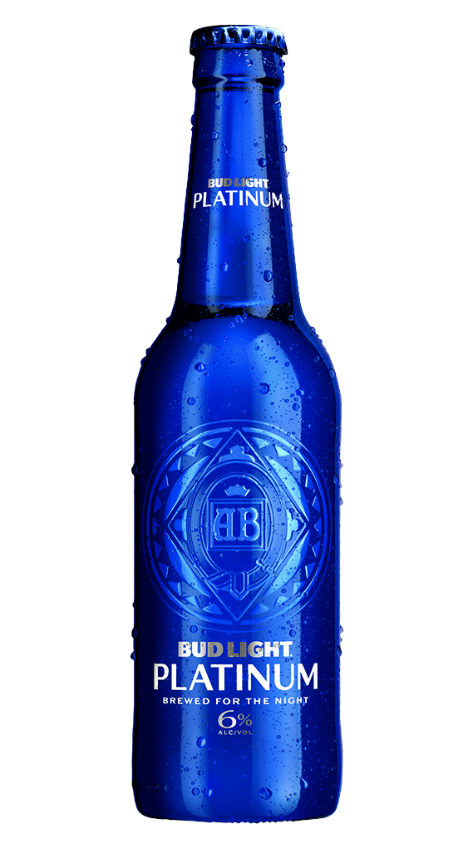Bud Light vs Bud Light Platinum
When thinking of light beers, Bud Light remains the King. It’s a staple of low-calorie, low-cost beers everywhere from your neighborhood tavern to stadiums around the world, and it offers a reliable buzz that doesn’t sacrifice taste or experience. But, there is a challenger to the throne, and its name is Bud Light Platinum.
While Bud Light Platinum may be slightly more expensive, it’s also a bit more flavorful and features a higher alcohol content. Of course, nothing is as perfect as it seems, and that means it also features a higher calorie count as well.
To help you choose your next pack of brews, this guide will go over everything you need to know about Bud Light vs Platinum!
All About Bud Light

Debuting in 1982, Bud Light has become one of the world’s most popular beers by total sales and recognition. It’s a readily available beer that is popular in nearly all market demographics from gender to age, location, and occupation. It’s rare to say that a beer transcends boundaries and borders, but Bud Light certainly does all that!
Marketed as a lower calorie and less alcoholic version of the flagship Budweiser lager, Bud Light is a light and smooth lager that’s seen everywhere from frat parties to concerts, theaters, sporting events, pubs and in fridges across the globe.
Here’s a quick nutritional chart to see how Bud Light fares against the original Budweiser lager in 12oz servings:
| Budweiser | 5% alc | 145 calories | 10.6 carbs | 0g fat |
| Bud Light | 4.2% alc | 110 calories | 6.6 carbs | 0g fat |
While the differences may not seem huge at first, the reduced calories and carbs add up tremendously over increased servings. Plus, the reduced alcohol content allows you to space your drinking out during events without getting too buzzed.
What is Bud Light Platinum?

Bud Light Platinum entered the US market in 2012 as an alternative to the standard Bud Light. At 6% alcohol and 139 calories per 12oz, it remains a bit of a unique brew. The alcohol content is slightly higher than your average lager, yet the calorie content remains very low for a lager with this much alcohol.
Bud Light vs Bud Light Platinum Alcohol Content per 12oz:
| Bud Light Platinum | 6% alc | 139 calories | 3g sugar | 0g fat |
| Bud Light | 4.2% alc | 110 calories | 0g sugar | 0g fat |
Bud Light Platinum was initially marketed as a “higher class” version of Bud Light that would be available in dance clubs and other sleek venues. The deep blue bottles and cans practically invite themselves onto dance floors, and the marketing for Platinum generally features clubs whereas the original Bud Light marketing focuses on sports, BBQs, and overall rougher events.
Is Bud Light Similar in Taste to Bud Light Platinum?
Bud Light is a lager that has a burnt oat taste at the forefront along with subtle notes of wheat, grass, and of course, barley and malt. Overall, it’s a very light beer, and the ingredients do feel a bit watered down, although that’s to be expected given the low alcohol and calorie content. When served cold, it’s mildly bubbly, refreshing, and gets the job done!
The taste of Bud Light Platinum, however, is essentially Bud Light, only more of the flavors are present and there’s a sweeter undertone. It’s not drastically stronger, but the flavors pop more and are more noticeable with each sip. The carbonation remains roughly the same as well.
Are the Ingredients Different in Bud Light vs Bud Light Platinum?

While many brands use corn syrup as the base for fermentation when making beer, Bud Light uses rice instead to help reduce the calorie and alcohol content. The ingredients of Bud Light include:
• Rice
• Barley malt
• Assorted hops
• Water
Bud Light Platinum has a similar ingredient profile, although it has a few big differences from Bud Light. It doesn’t have any rice in it, and it adds corn along with cane syrup to increase the drink’s sweetness and provide a fuller taste.
The ingredients of Bud Light Platinum include:
• Water
• Corn
• Barley Malt
• Cane Syrup
• Hop Extract
Do Bud Light and Bud Light Platinum Cost the Same Amount?
Both Bud Light and Bud Light Platinum are available in single serve cans, six packs, plus 12 or more packs, and they are on draft in countless bars and restaurants. However, Platinum is the more expensive beer although it does cost less than your average craft IPA.
While prices are subject to change, and there’s always a sale to be had, Bud Light Platinum is generally more expensive than the original Bud Light.
What’s the Best Thing About Bud Light?
Bud Light remains the King of Light Beers for a reason: it’s available everywhere, it’s cheap, and it’s pretty inoffensive taste-wise as well as having no added preservatives. It’s not a mind-blowing beer, but it’s also not bad. It’s hard to imagine refusing a Bud Light if it’s offered, and even the snobbiest beer snob will likely go for seconds on a sunny day.
In short: it does exactly what it promises to do. As a low-cost, low-alcohol, and low-calorie beer, you really can’t go wrong with Bud Light!
What’s the Best Thing About Bud Light Platinum?
The single best thing about Bud Light Platinum is that it’s a high-alcohol yet low-calorie beer. If Bud Light just doesn’t quite get you where you want to be, Platinum is sure to do it without all the extra calories!
Plus, it does have a sweeter taste which can be preferable for those who want a less bitter drink.
Who Should Get Bud Light?

Bud Light is the perfect beer for:
- BBQs
- BYOB events
- Watching sports
- Day drinking
- Concerts
- Parties
It’s drinkable, light, and refreshing enough to be good in any weather, making it a standard beer for countless occasions.
Who Should Get Bud Light Platinum?
With a higher cost, sweeter taste, and higher alcohol content, Bud Light Platinum may not be the best drink to bring in large quantities to events. However, it’s great for individuals who want a stronger yet still light beer! Of course, if your friends like it and you don’t mind paying a bit extra, it can still be a great beer for any event, although it’s not quite as binge-able as the original due to its heavier and sweeter taste.